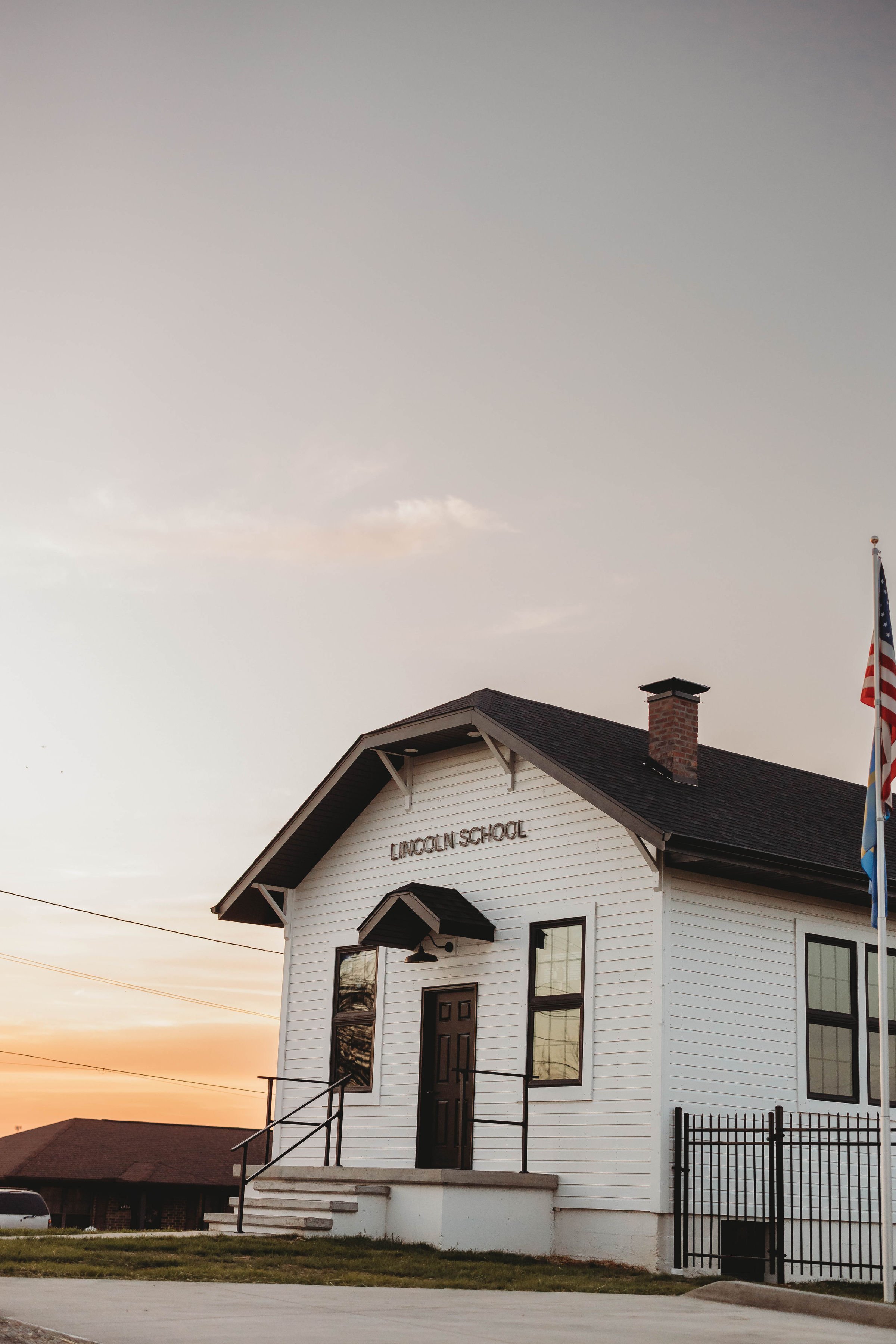
The Lincoln Legacy
The statues at Reflection Plaza are profound symbols of Lincoln School’s historical impact and the spirit of resilience, love, and patriotism that has characterized its community. These statues capture meaningful moments from the school’s legacy, blending past and present to inspire future generations. Both statues were constructed by Matthew Glen and his team at Big Statues, LLC, in Provo, Utah.
I, Too, Am American
I, Too, Am America is a powerful tribute to resilience and patriotism. Created from a sketch by world-renowned artist Cbabi Bayoc and inspired by a 1942 photograph of Lincoln School students, it portrays a young boy standing in salute. This statue honors the efforts of Lincoln School’s teachers, who, despite the oppressive Jim Crow laws and segregation practices of the era, ensured their students learned the Pledge of Allegiance. In this simple act, they instilled a sense of belonging, pride, and unity in their students—a testament to the strength and enduring patriotism of a community that held steadfast to its values in the face of systemic adversity. Together, these statues at Reflection Plaza represent the unyielding spirit and dedication of Lincoln School’s community, serving as lasting reminders of love, resilience, and the enduring American spirit.
-
The pedestal murals, entitled, “On Shoulders, We Stand”
The pedestal for I, Too, Am America is a bold expression of patriotism and deep-rooted community legacy. The front of the pedestal features a waving American flag, symbolizing the patriotism instilled within the Lincoln School classroom. Despite the political and social struggles of the era, teachers recognized the importance of imparting patriotic values to their students—an act of faith and hope in the ideals of freedom and unity.
On the left side of the pedestal as you face the statue, a scripture from Proverbs 27:19—"As water reflects the face, so one’s life reflects the heart"—encourages viewers to engage in introspection and consider the enduring impact of their actions. Atop the pedestal, a tree with its roots running down the back symbolizes the enduring presence and historical contributions of African Americans in this community. These roots serve as a powerful metaphor: our roots run deep in this community, grounding us firmly in its history and progress. In addition, the African Proverb – “When the roots are deep there is no reason to fear the wind,” is featured—underscoring the deep importance of family and legacy in shaping identity and purpose. The community know referred to as “the Hill” was grounded in strong values, heritage, and inner strength, this gave the ability to withstand adversity. Note: Dr. Ogunwo utilized DNA structure to symbolize that our ancestors blood runs deep in the historic segregated district of West Plains known as “The Hill.”
The right side of the pedestal pays tribute to the Black men—both local and national—who have laid the foundation for learning and growth through their sacrifices and perseverance. These are the shoulders upon which we still stand, a constant reminder that the path forward is fortified by their strength and resilience. A few of those depicted are from left to right on the back row: Abe Taylor, Pony Thomas, Crockett W. Oaks Sr., James Monroe Forbes, James Baldwin, CPO (R) Lawrence “Larry” Lee Forbes, James Neal Talton, SSG Robert “Bob” A. Givehand. Front row: from left to right, W.E.B. DuBois, George Washington Carver, Martin Luther King, Jr. Nelson Mandela, PVT Jewell Talton.
Feel the Love
Feel the Love, depicts a young girl with her hands shaped into a heart—a modern gesture of love and connection. This statue is modeled after a childhood photo of Tonya Oaks, one of the founders of the Lincoln School Project, and embodies a timeless expression that resonates deeply across generations. The statue serves as an invitation for all who visit Reflection Plaza to hold close the legacy of Lincoln School in their hearts. It beautifully aligns with the project’s vision of “the past in our hearts, the present on our minds, and the future in our hands,” representing the love and dedication that have sustained this historic place.
-
The pedestal supporting Feel the Love is a testament to the unyielding spirit of Black women, whose contributions often bloomed under the harshest of circumstances. The front and top of the pedestal are adorned with flowers native to Africa—each petal and stem symbolizing the vibrancy of life before the cruel disruption of the Trans-Atlantic Slave Trade. These flowers represent not just flora, but the lives, cultures, and aspirations that were plucked from their homeland and scattered across foreign soil.
Turning to the back of the pedestal, the narrative continues with a depiction of women picking cotton—a haunting reflection of the new 'flowers' they were forced to gather upon their arrival in America. The contrast between the flowers of Africa and the cotton fields of America serves as a stark reminder of displacement and forced labor, yet also a symbol of resilience and survival.
Flanking both sides of the pedestal are the faces of 30 Black women—both local (left) ancestors and national figures (right)—who have paved the way for progress and change. These are the shoulders we stand upon today, women who toiled, resisted, and persevered against unimaginable odds, ensuring that their strength would carry forward to empower future generations.
This visual art installation is not only a representation of history; it is a bridge that links the sacrifices of the past to the promises of the future, inviting us all to reflect, remember, and rise in unity and love.

Both Feel the Love and I Too, Am American are more than mere representations; they are visual testaments to the power of memory and the resilience of community. Through their intricate designs, each pedestal speaks to the journey of Black Americans—from displacement and struggle to growth and triumph. Standing upon these murals, the sculptures invite reflection on the enduring legacies of those who came before, whose sacrifices and strength continue to guide the path forward. Reflection Plaza, through these powerful visual narratives, becomes a sacred space of acknowledgment, unity, and hope for the future.





